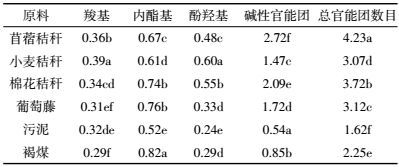文章信息
- 孙涛, 朱新萍, 李典鹏, 顾祝禹, 张佳喜, 贾宏涛
- SUN Tao, ZHU Xin-ping, LI Dian-peng, GU Zhu-yu, ZHANG Jia-xi, JIA Hong-tao
- 不同原料生物炭理化性质的对比分析
- Comparison of Biochars Characteristics from Different Raw Materials
- 农业资源与环境学报, 2017, 34(6): 543-549
- Journal of Agricultural Resources and Environment, 2017, 34(6): 543-549
- http://dx.doi.org/10.13254/j.jare.2017.0158
-
文章历史
- 收稿日期: 2017-06-14
录用日期: 2017-09-13
2. 新疆农业大学机械交通学院, 新疆 乌鲁木齐 830052
2. Mechanical and Traffic College, Xinjiang Agricultural University, Urumqi 830052, China
生物炭是生物质材料在限氧、低温( < 700 ℃)环境下,经加热分解最终获得的一种碳含量丰富的固态产物[1]。因其表面具有丰富的孔隙结构[2],以及稳定的脂肪族链状结构和高度芳香化结构,使其具有很好的吸附性和稳定性[3],已成为在增加碳固存和修复土壤环境方向的一种新材料[4-6]。生物炭一般呈碱性,养分含量较高,也可用于农田土壤的改良,增加土壤肥力、改善土壤的结构[7-9]。生物炭的性质与炭化工艺有着很密切的联系[10-13],炭化时间和炭化温度对生物炭性质有着显著的影响,且随着炭化温度的升高、炭化时间的延长,生物炭的有机碳含量、阳离子交换量都随之降低,而灰分、比表面会逐渐上升[14-16]。同时,炭化原料也会对生物炭的性质产生一定影响[17-19],原料与生物炭表面官能团的种类和数目以及表面化学性质都有极大的关系[20-21]。
生物炭的应用范围已经涉及到环境修复、土壤改良等多个领域。目前对生物炭生产工艺的研究较多,但即使炭化加工参数相同,不同原材料制成的生物炭也存在一定差异,从而影响到其应用的领域和范围。为此,本研究以苜蓿秸秆生物炭、小麦秸秆生物炭、葡萄藤生物炭、污泥生物炭和褐煤生物炭6种生物炭为研究材料,探究不同原料生物炭性质的差异,为工农业废弃物生物炭制备工艺及其应用推广提供参考数据。
1 材料与方法 1.1 生物炭材料苜蓿秸秆生物炭(400 ℃、4 h)、小麦秸秆生物炭(400 ℃、4 h)、棉花秸秆生物炭(360 ℃、24 h)、葡萄藤生物炭(400 ℃、24 h)来自新疆农业大学草业与环境科学学院,污泥生物炭(600 ℃、0.5 h)、褐煤生物炭(600 ℃、0.5 h)由密西西比国际(中国)水务有限公司提供。
1.2 分析方法生物炭的pH值采用水浸提法(GB/T 12496.7—1999),有机碳含量采用K2Cr2O7-浓H2SO4外加热法,阳离子交换量采用乙酸钠-火焰光度计法。官能团定性分析采用傅里叶红外光谱(WQF-510,China),官能团定量分析采用Boehm滴定法[22]。生物炭微结构观测使用电子显微镜(Hitachi S-570型)。
1.3 统计方法实验数据使用Excel2003、Origin9.0和SPSS19.0进行统计与绘图,采用单因素方差分析(ANOVA)及多重比较(LSD)进行数据显著性分析。
2 结果与讨论 2.1 不同原料生物炭pH值的比较生物炭施入土壤中,会引起土壤pH值的改变,从而会导致土壤氮素矿化、废料质沉淀、温室气体排放等一系列问题[23-25]。因此,生物炭作为土壤改良剂时,其本身的pH值是不可忽略的因素。大多数研究表明,生物炭一般呈碱性[26-28]。本研究中,除污泥生物炭呈弱酸性外,其他生物炭均呈碱性。如图 1所示,苜蓿秸秆生物炭、小麦秸秆生物炭、棉花秸秆生物炭、葡萄藤生物炭、污泥生物炭、褐煤生物炭的pH值分别为9.81、9.75、9.55、9.96、6.76、8.49。比较不同原料生物炭的pH值发现,葡萄藤生物炭>苜蓿秸秆生物炭、小麦秸秆生物炭>棉花秸秆生物炭>褐煤生物炭>污泥生物炭。原料性质的差异,导致其制成生物炭的pH值也有一定差异。苜蓿秸秆、小麦秸秆、棉花秸秆、葡萄藤本身均含有多种植物酸,在炭化过程中,植物中的酸不断分解,灰分不断生产,从而导致了生物炭pH值的升高[29]。褐煤中含有一定的矿质元素,随着生物质不断被热解,生物炭的产量逐渐降低,使得原料中的矿质元素含量逐渐升高,从而使得生物炭呈碱性[30]。Hossain等[31]也发现污泥生物炭呈酸性,这可能与较低的炭化温度和较短的炭化时间有关。
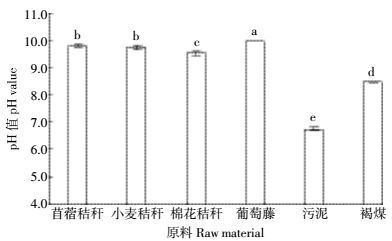
|
| 图 1 不同原料生物炭pH值的比较 Figure 1 Comparison of biochar pH value from different raw materials |
生物炭富含有机碳,施于土壤中可增加土壤肥力,从而提高作物的产量[32];同时也被作为一种碳封存剂施于土壤中,来增加陆地碳封存、减少温室气体的排放[33-34]。如图 2所示,苜蓿秸秆生物炭、小麦秸秆生物炭、棉花秸秆生物炭、葡萄藤生物炭、污泥生物炭和褐煤生物炭的有机碳含量分别为588.43、539.95、578.70、503.97、168.17、193.85 g·kg-1。比较不同原料生物炭的有机碳含量发现,苜蓿秸秆生物炭>棉花秸秆生物炭>小麦秸秆生物炭>葡萄藤生物炭>褐煤生物炭>污泥生物炭。同时可以发现,植物类原料生物炭的有机碳含量显著高于矿物类原料生物炭,这与许艳萍等[35]和Khanmohammadi等[36]研究结果一致。主要是因为绿色植物本身具有固碳功能[37],使其含有较高有机碳;而污泥、褐煤本身的有机碳含量较低。这表明原料有机碳含量对生物炭有机碳含量有着较大的影响。
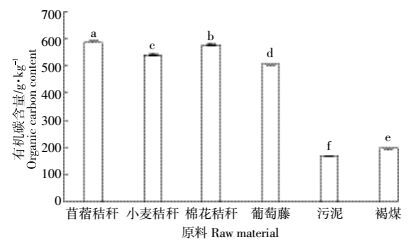
|
| 图 2 不同原料生物炭有机碳含量的比较 Figure 2 Comparison of biochar organic carbon content from different raw materials |
CEC(阳离子交换量)通常被确认为是土壤固定阳离子能力的重要指标,阳离子交换量能够反映出生物炭表面的负电荷参数,其大小也决定了生物炭对土壤中阳离子的持留能力。生物炭的离子吸附交换能力能够增强土壤的阴阳离子交换,从而增强土壤的保水保肥能力[38-40]。如图 3所示,苜蓿秸秆生物炭、小麦秸秆生物炭、棉花秸秆生物炭、葡萄藤生物炭、污泥生物炭、褐煤生物炭的阳离子交换量分别为49.24、34.91、49.56、41.60、33.25、25.02 cmol·kg-1。比较不同原料生物炭的阳离子交换量发现,苜蓿秸秆生物炭、棉花秸秆生物炭>葡萄藤生物炭>小麦秸秆生物炭>污泥生物炭>褐煤生物炭。
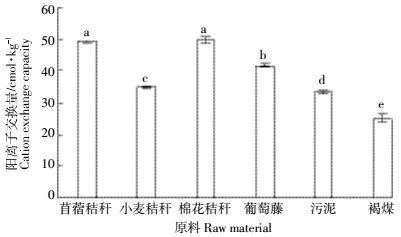
|
| 图 3 不同原料生物炭阳离子交换量的比较 Figure 3 Comparison of biochar cation exchange capacity from different raw materials |
FTIR图谱能够表征生物炭表面不同的官能团,6种生物炭的特征吸收峰大致相同,均在3 429、2 921、2 845、1 622、1 577、1 506、1 384、795 cm-1处都有较为明显的吸收峰(图 4)。在3 429 cm-1处的伸缩振动宽峰,表明不同原料的生物炭均有明显的-OH,在2 921 cm-1和2 845 cm-1的吸收峰主要是生物炭中脂肪烃或环烷烃中-CH2伸缩振动而引起的,C=C的吸收峰出现在1 622 cm-1处,1 577、1 506 cm-1处的吸收峰能够清晰地显示苯环的存在,这表明生物质在炭化过程中,已经形成了良好的芳香结构。1 300 cm-1以下的区域为红外光谱的指纹区,在795 cm-1处6种生物炭均有较强的芳环C-H弯曲振动吸收峰。在1 027 cm-1处,仅有污泥生物炭有较强的吸收峰,此峰代表的污泥生物炭具有Si-O-C或Si-O-Si结构,这可能与污泥生物炭灰分中含Si元素有关。在864 cm-1处,相较于矿物类生物炭(污泥生物炭和褐煤生物炭),植物类生物炭(苜蓿秸秆生物炭、小麦秸秆生物炭、棉花秸秆生物炭、葡萄藤生物炭)有着明显的C-O的吸收峰。这主要是由于植物类生物炭原料中含有较为丰富的纤维素和糖类物质。根据6种生物炭的红外图谱可以准确地判断出生物炭的结构主要以芳环骨架为主[41-43]。
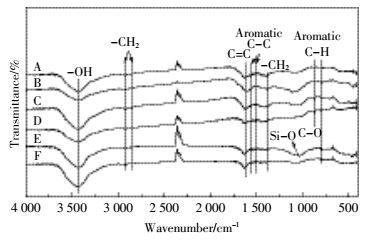
|
| A、B、C、D、E、F分别代表的是苜蓿秸秆生物炭、小麦秸秆生物炭、棉花秸秆生物炭、葡萄藤生物炭、污泥生物炭、褐煤生物炭。 A, B, C, D, E, F represents alfalfa straw biochar, wheat straw biochar, cotton straw biochar, grape vines biochar, sludge biochar and lignite biochar, respectively 图 4 不同原料生物炭的红外光谱图 Figure 4 FTIR of biochar from different raw materials |
Boehm滴定法是根据不同的酸碱与不同的含氧官能团的反应特征,对物质表面的官能团进行定量分析。生物炭具有丰富的孔隙结构,在炭化过程中,有一部分孔隙会被损坏,使得生物炭表面的结构发生改变,而氢原子和氧原子则会吸附在一些被破坏的孔隙上,从而会形成一些含氧官能团[44]。生物炭表面官能团的数量和种类对生物炭的表面物理、化学性质都有着很大的影响,而含氧官能团是生物炭表面最主要的官能团,其影响着生物炭对养分、水分以及一些金属离子的吸附能力[45-46]。
从表 1中可以看出,原材料对生物炭表面的含氧官能团有着一定的影响。苜蓿秸秆生物炭的总官能团数目要显著大于其他生物炭,而污泥生物炭的总官能团数是6种生物炭中最低的(P < 0.05)。比较不同生物炭表面的含氧官能团数目可以发现,苜蓿秸秆生物炭>棉花秸秆生物炭>葡萄藤生物炭>小麦秸秆生物炭>褐煤生物炭>污泥生物炭。
不同原料生物炭的扫描电镜图如图 5所示,从图中可以看出,苜蓿秸秆生物炭、小麦秸秆生物炭、棉花秸秆生物炭、葡萄藤生物炭表面均有明显的孔隙结构,但孔隙的结构、数目均有一定的差异。苜蓿秸秆生物炭、小麦秸秆生物炭、棉花秸秆生物炭和葡萄藤生物炭表面孔隙结构排列整齐,形状各异,且苜蓿秸秆生物炭、小麦秸秆生物炭和葡萄藤生物炭表面的孔隙数目显著多于棉花秸秆生物炭,而棉花生物炭表面虽然有明显的孔隙结构,但可能由于炭化时间过长使得孔隙结构遭到一定的破坏。褐煤生物炭和污泥生物炭表面并无明显的孔隙结构,污泥生物炭表面粗糙、富含颗粒,褐煤生物炭表面较为光滑,同时也有颗粒附着在表面。

|
| A、B、C、D、E、F分别代表的是苜蓿秸秆生物炭、小麦秸秆生物炭、棉花秸秆生物炭、葡萄藤生物炭、污泥生物炭、褐煤生物炭 A, B, C, D, E, F represents alfalfa straw biochar, wheat straw biochar, cotton straw biochar, grape vines biochar, sludge biochar, lignite biochar, respectively 图 5 不同原料生物炭的扫描电镜图 Figure 5 SEM images of biochars from different raw materials |
通过不同原料生物炭性质与结构的比较分析可以得出以下结论:
(1)除污泥生物炭呈弱酸性外,其他生物炭均呈碱性。6种生物炭pH值的大小顺序为葡萄藤生物炭>苜蓿秸秆生物炭、小麦秸秆生物炭>棉花秸秆生物炭>褐煤生物炭>污泥生物炭。生物炭的有机碳含量较高,不同原料生物炭有机碳含量有一定差异,大小顺序为:苜蓿秸秆生物炭>棉花秸秆生物炭>小麦秸秆生物炭>葡萄藤生物炭>褐煤生物炭>污泥生物炭。本研究中生物炭的阳离子交换量为25~49 cmol·kg-1,大小顺序为苜蓿秸秆生物炭、棉花秸秆生物炭>葡萄藤生物炭>小麦秸秆生物炭>污泥生物炭>褐煤生物炭。
(2)FTIR红外表征显示,6种生物炭表面都存在芳香烃类和含氧基团,并可以得出生物炭结构以芳环骨架为主。苜蓿生物炭的表面总官能团数含量最多,污泥生物炭含量最少,并且除污泥生物炭外,其他5种生物炭的碱性官能团数目均大于酸性官能团数目。
(3)苜蓿秸秆生物炭、小麦秸秆生物炭、棉花秸秆生物炭、葡萄藤生物炭表面均有明显的孔隙结构,但孔隙的结构、数目均有一定的差异。褐煤生物炭和污泥生物炭表面并无明显的孔隙结构。
综上,6种生物炭表面含有丰富的官能团和孔隙结构,其他理化性质也略有不同。植物类生物炭有机碳含量和阳离子交换量显著高于矿物类生物炭,更适于农田土壤改良与培肥;污泥生物炭和褐煤生物炭可在污染土壤的修复实践中进行应用。同时,污泥生物炭为弱酸性,因此施用污泥生物炭可为盐碱土的改良提供新思路。
| [1] |
Lehmann J D, Joseph S. Biochar for environmental management:Science and Technology[M]. UK and USA: Earthscan, 2009, 1-2.
|
| [2] |
Schmidt M W I, Noack A G. Black carbon in soils and sediments:Analysis, distribution, implications, and current challenges[J]. Global Biogeochemical Cycles, 2000, 14(3): 777-793. DOI:10.1029/1999GB001208 |
| [3] |
陈温福, 张伟明, 孟军. 生物炭与农业环境研究回顾与展望[J]. 农业环境科学学报, 2014, 33(5): 821-828. CHEN Wen-fu, ZHANG Wei-ming, MENG Jun. Biochar and agro-ecological environment:Review and prospect[J]. Journal of Agro-Environment Science, 2014, 33(5): 821-828. DOI:10.11654/jaes.2014.05.001 (in Chinese) |
| [4] |
Li B, Yang L, Wang C, et al. Adsorption of Cd(Ⅱ) from aqueous solutions by rape straw biochar derived from different modification processes[J]. Chemosphere, 2017, 175: 332-340. DOI:10.1016/j.chemosphere.2017.02.061 |
| [5] |
仓龙, 朱向东, 汪玉, 等. 生物质炭中的污染物含量及其田间施用的环境风险预测[J]. 农业工程学报, 2012, 28(15): 163-167. CANG Long, ZHU Xiang-dong, WANG Yu, et al. Pollutant contents in biochar and their potential environmental risks for field application[J]. Transactions of the CSAE, 2012, 28(15): 163-167. (in Chinese) |
| [6] |
董双快, 王丽萍, 李典鹏, 等. 生物炭对苏丹草吸收Cd、Pb的影响[J]. 干旱区资源与环境, 2017, 31(5): 186-191. DONG Shuang-kuai, WANG Li-ping, LI Dian-peng, et al. Effect of biochar on Cd and Pb absorption of sudangrass[J]. Journal of Arid Land Resources and Environment, 2017, 31(5): 186-191. (in Chinese) |
| [7] |
张旭辉, 李治玲, 李勇, 等. 施用生物炭对西南地区紫色土和黄壤的作用效果[J]. 草业学报, 2017, 26(4): 63-72. ZHANG Xu-hui, LI Zhi-ling, LI Yong, et al. Effect of biochar amendment on purple and yellow soil[J]. Acta Prataculturae Sinica, 2017, 26(4): 63-72. DOI:10.11686/cyxb2016367 (in Chinese) |
| [8] |
赵倩雯. 生物炭对大白菜幼苗生长及根肿病的影响[D]. 沈阳: 沈阳农业大学, 2016. ZHAO Qian-wen.Effect of biochar on growth and clubroot of Brassica campestris L.ssp.pekinesis(Lour) Olsson[D].Shenyang:Shenyang Agricultural University, 2016.(in Chinese) |
| [9] |
张伟明. 生物炭的理化性质及其在作物生产上的应用[D]. 沈阳: 沈阳农业大学, 2012. ZHANG Wei-ming.Physical and chemical properties of biochar and its application in crop production[D].Shenyang:Shenyang Agricultural University, 2012.(in Chinese) |
| [10] |
简敏菲, 高凯芳, 余厚平. 不同裂解温度对水稻秸秆制备生物炭及其特性的影响[J]. 环境科学学报, 2016, 36(5): 1757-1765. JIAN Min-fei, GAO Kai-fang, YU Hou-ping. Effects of different pyrolysis temperatures on the preparation and characteristics of biochar from rice straw[J]. Acta Scientiae Circumstantiae, 2016, 36(5): 1757-1765. (in Chinese) |
| [11] |
何云勇, 李心清, 杨放, 等. 裂解温度对新疆棉秆生物炭物理化学性质的影响[J]. 地球与环境, 2016, 44(1): 19-24. HE Yun-yong, LI Xin-qing, YANG Fang, et al. Effect of pyrolysis temperature on physicochemical properties of Xinjiang cotton-straw biochar[J]. Earth & Environment, 2016, 44(1): 19-24. (in Chinese) |
| [12] |
吴志丹, 尤志明, 江福英, 等. 不同温度和时间炭化茶树枝生物炭理化特征分析[J]. 生态与农村环境学报, 2015, 31(4): 583-588. WU Zhi-dan, YOU Zhi-ming, JIANG Fu-ying, et al. Physico-chemical properties of tea-twig-derived biochars different in temperature and duration of pyrolysis[J]. Journal of Ecology and Rural Environment, 2015, 31(4): 583-588. DOI:10.11934/j.issn.1673-4831.2015.04.022 (in Chinese) |
| [13] |
王宏燕, 王晓晨, 张瑜洁, 等. 几种生物质热解炭基本理化性质比较[J]. 东北农业大学学报, 2016, 47(5): 83-90. WANG Hong-yan, WANG Xiao-chen, ZHANG Yu-jie, et al. Comparison of biochars characteristics from biomass residues produced through slow pyrolysis[J]. Journal of Northeast Agricultural University, 2016, 47(5): 83-90. (in Chinese) |
| [14] |
姚红宇, 唐光木, 葛春辉, 等. 炭化温度和时间与棉秆炭特性及元素组成的相关关系[J]. 农业工程学报, 2013, 29(7): 199-206. YAO Hong-yu, TANG Guang-mu, GE Chun-hui, et al. Characteristics and elementary composition of cotton stalk-char in different carbonization temperature and time[J]. Transactions of the CSAE, 2013, 29(7): 199-206. (in Chinese) |
| [15] |
牛明芬, 刘欢, 张玉兰, 等. 玉米秸秆炭与炭化温度和时间的关系[J]. 安徽农业科学, 2016, 44(12): 25-27. NIU Ming-fen, LIU Huan, ZHANG Yu-lan, et al. Relationship between the corn straw carbon and the carbonization temperature and time[J]. Journal of Anhui Agricultural Sciences, 2016, 44(12): 25-27. DOI:10.3969/j.issn.0517-6611.2016.12.008 (in Chinese) |
| [16] |
Yuan J H, Xu R K, Zhang H. The forms of alkalis in the biochar produced from crop residues at different temperatures[J]. Bioresource Technology, 2011, 102(3): 3488-3497. DOI:10.1016/j.biortech.2010.11.018 |
| [17] |
Novak J M, Cantrell K B, Watts D W, et al. Designing relevant biochars as soil amendments using lignocellulosic-based and manure-based feedstocks.[J]. Journal of Soils and Sediments, 2014, 14(2): 330-343. DOI:10.1007/s11368-013-0680-8 |
| [18] |
Liu Y, He Z, Uchimiya M. Comparison of biochar formation from various agricultural by-products using FTIR spectroscopy[J]. Modern Applied Science, 2015, 9(4): 247-256. |
| [19] |
张千丰, 孟军, 刘居东, 等. 热解温度和时间对三种作物残体生物炭pH值及碳氮含量的影响[J]. 生态学杂志, 2013, 32(9): 2347-2353. ZHANG Qian-feng, MENG Jun, LIU Ju-dong, et al. Effects of pyrolysis temperature and duration time on pH, carbon and nitrogen contents of biochars produced from three crop residues[J]. Chinese Journal of Ecology, 2013, 32(9): 2347-2353. (in Chinese) |
| [20] |
孟冠华, 李爱民, 张全兴. 活性炭的表面含氧官能团及其对吸附影响的研究进展[J]. 离子交换与吸附, 2007, 23(1): 88-94. MENG Guan-hua, LI Ai-min, ZHANG Quan-xing. Studies on the oxygen-containing groups of activated carbon and their effects on the adsorption character[J]. Ion Exchange and Adsorption, 2007, 23(1): 88-94. (in Chinese) |
| [21] |
Tsechansky L, Graber E R. Methodological limitations to determining acidic groups at biochar surfaces via the Boehm titration[J]. Carbon, 2014, 66(1): 730-733. |
| [22] |
高凯芳, 简敏菲, 余厚平, 等. 裂解温度对稻秆与稻壳制备生物炭表面官能团的影响[J]. 环境化学, 2016, 35(8): 1663-1669. GAO Kai-fang, JIAN Min-fei, YU Hou-ping, et al. Effects of pyrolysis temperatures on the biochars and its surface functional groups made from rice straw and rice husk[J]. Environmental Chemistry, 2016, 35(8): 1663-1669. DOI:10.7524/j.issn.0254-6108.2016.08.2016010607 (in Chinese) |
| [23] |
Fidel R B, Laird D A, Thompson M L, et al. Characterization and quantification of biochar alkalinity[J]. Chemosphere, 2017, 167: 367-373. DOI:10.1016/j.chemosphere.2016.09.151 |
| [24] |
Mccormack S A, Ostle N, Bardgett R D, et al. Biochar in bioenergy cropping systems:Impacts on soil faunal communities and linked ecosystem processes.[J]. Global Change Biology Bioenergy, 2013, 5(2): 81-95. DOI:10.1111/gcbb.12046 |
| [25] |
Williamson Phil. Emissions reduction:Scrutinize CO2 removal methods[J]. Nature, 2016, 530(7589): 153-155. DOI:10.1038/530153a |
| [26] |
戴中民. 生物炭对酸化土壤的改良效应与生物化学机理研究[D]. 杭州: 浙江大学, 2017. DAI Zhong-min.The effects of biochar on acid soil improvement and the related biochemical mechanisms[D].Hangzhou:Zhejiang University, 2017.(in Chinese) |
| [27] |
曾理, 王翠红, 邝美娟, 等. 我国南方3种主要作物秸秆炭的理化特性研究[J]. 湖南农业科学, 2017(2): 39-42. ZENG Li, WANG Cui-hong, KUANG Mei-juan, et al. Physical and chemical properties of three main crop straw charcoal in south China[J]. Hunan Agricultural Sciences, 2017(2): 39-42. (in Chinese) |
| [28] |
林珈羽, 张越, 刘沅, 等. 不同原料和炭化温度下制备的生物炭结构及性质[J]. 环境工程学报, 2016, 10(6): 3200-3206. LIN Jia-yu, ZHANG Yue, LIU Yuan, et al. Structure and properties of biochar under different materials and carbonization temperatures[J]. Chinese Journal of Environmental Engineering, 2016, 10(6): 3200-3206. DOI:10.12030/j.cjee.201501107 (in Chinese) |
| [29] |
Lehmann J. Bio-energy in the black[J]. Frontiers in Ecology & the Environment, 2007, 5(7): 381-387. |
| [30] |
Gaskin J W, Steiner C, Harris K, et al. Effect of low-temperature pyrolysis conditions on biochar for agricultural use[J]. Transactions of the ASABE, 2008, 51(6): 2061-2069. DOI:10.13031/2013.25409 |
| [31] |
Hossain M K, Strezov V, Chan K Y, et al. Influence of pyrolysis temperature on production and nutrient properties of wastewater sludge biochar[J]. Journal of Environmental Management, 2011, 92(1): 223-228. DOI:10.1016/j.jenvman.2010.09.008 |
| [32] |
刘悦, 黎子涵, 邹博, 等. 生物炭影响作物生长及其与化肥混施的增效机制研究进展[J]. 应用生态学报, 2017, 28(3): 1030-1038. LIU Yue, LI Zi-han, ZOU Bo, et al. Research progress in effects of biochar application on crop growth and synergistic mechanism of biochar with fertilizer[J]. Chinese Journal of Applied Ecology, 2017, 28(3): 1030-1038. (in Chinese) |
| [33] |
Smith P. Soil carbon sequestration and biochar as negative emission technologies[J]. Global Change Biology, 2016, 22(3): 1315-1324. DOI:10.1111/gcb.13178 |
| [34] |
Zhou H, Zhang D, Wang P, et al. Changes in microbial biomass and the metabolic quotient with biochar addition to agricultural soils:A meta-analysis[J]. Agriculture Ecosystems & Environment, 2017, 239: 80-89. |
| [35] |
许燕萍, 谢祖彬, 朱建国, 等. 制炭温度对玉米和小麦生物质炭理化性质的影响[J]. 土壤, 2013, 45(1): 73-78. XU Yan-ping, XIE Zu-bin, ZHU Jian-guo, et al. Effects of pyrolysis temperature on physical and chemical properties of corn biochar and wheat biochar[J]. Soils, 2013, 45(1): 73-78. (in Chinese) |
| [36] |
Khanmohammadi Z, Afyuni M, Mosaddeghi M R. Effect of pyrolysis temperature on chemical and physical properties of sewage sludge biochar[J]. Waste Management & Research, 2015, 33(3): 275-283. |
| [37] |
李新宇, 唐海萍. 陆地植被的固碳功能与适用于碳贸易的生物固碳方式[J]. 植物生态学报, 2006, 30(2): 200-209. LI Xin-yu, TANG Hai-ping. Carbon sequestration:Manners suitable for carbon trade in China and function of terrestrial vegetation[J]. Chinese Journal of Plant Ecology, 2006, 30(2): 200-209. DOI:10.17521/cjpe.2006.0029 (in Chinese) |
| [38] |
Liang B, Lehmann J, Solomon D, et al. Black carbon increases cation exchange capacity in soils[J]. Soil Science Society of America Journal, 2006, 70(5): 1719-1730. DOI:10.2136/sssaj2005.0383 |
| [39] |
Van Zwieten L, Kimber S, Morris S, et al. Effects of biochar from slow pyrolysis of papermill waste on agronomic performance and soil fertility[J]. Plant and Soil, 2010, 327(1): 235-246. |
| [40] |
Lee J W, Kidder M, Evans B R, et al. Characterization of biochars produced from corn stovers for soil amendment[J]. Environmental Science & Technology, 2010, 44(20): 7970-7974. |
| [41] |
郑庆福, 王永和, 孙月光, 等. 不同物料和炭化方式制备生物炭结构性质的FTIR研究[J]. 光谱学与光谱分析, 2014, 34(4): 962-966. ZHENG Qing-fu, WANG Yong-he, SUN Yue-guang, et al. Study on structural properties of biochar under different materials and carbonized by FTIR[J]. Spectroscopy and Spectral Analysis, 2014, 34(4): 962-966. (in Chinese) |
| [42] |
王格格, 李刚, 陆江银, 等. 热解工艺对污泥制备生物炭物理结构的影响[J]. 环境工程学报, 2016, 10(12): 7289-7293. WANG Ge-ge, LI Gang, LÜ Jiang-yin, et al. Effect of pyrolysical structure of biochar[J]. Chinese Journal of Environmental Engineering, 2016, 10(12): 7289-7293. DOI:10.12030/j.cjee.201507124 (in Chinese) |
| [43] |
Lawrinenko M, Jing D, Banik C, et al. Aluminum and iron biomass pretreatment impacts on biochar anion exchange capacity[J]. Carbon, 2017, 118: 422-430. DOI:10.1016/j.carbon.2017.03.056 |
| [44] |
Mukherjee A, Zimmerman A R, Harris W. Surface chemistry variations among a series of laboratory-produced biochars[J]. Geoderma, 2011, 163(3): 247-255. |
| [45] |
Li Hongbo, Dong Xiaoling, Evandro B da Silva, et al. Mechanisms of metal sorption by biochars:Biochar characteristics and modifications[J]. Chemosphere, 2017, 178: 466-478. DOI:10.1016/j.chemosphere.2017.03.072 |
| [46] |
Hilber I, Mayer P, Gouliarmou V, et al. Bioavailability and bioaccessibility of polycyclic aromatic hydrocarbons from(post-pyrolytically treated) biochars[J]. Chemosphere, 2017, 174: 700-707. DOI:10.1016/j.chemosphere.2017.02.014 |
 2017, Vol. 34
2017, Vol. 34





